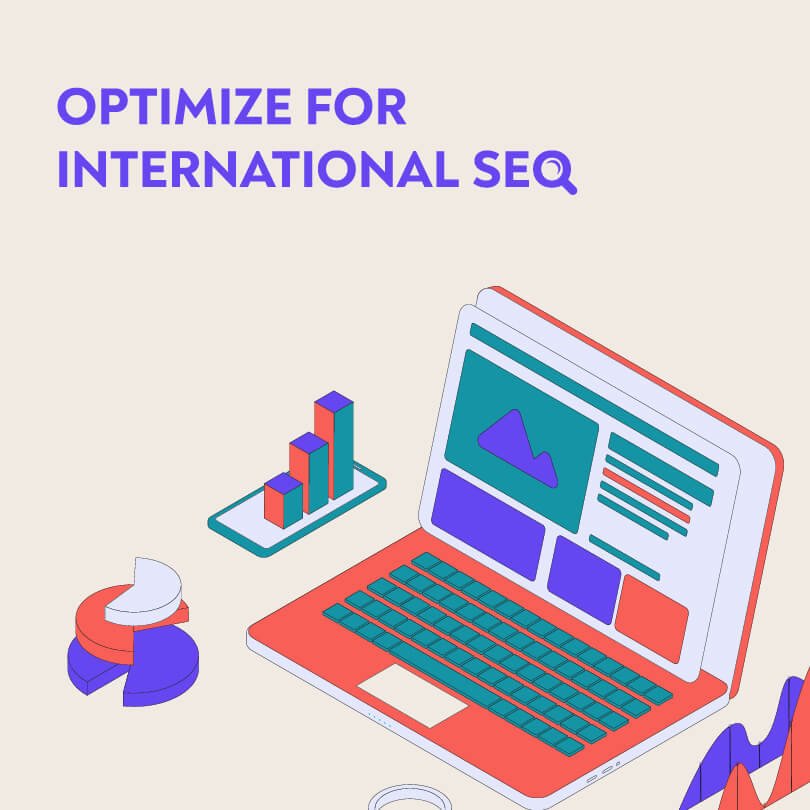After messing around with your metrics and insights, you came to the conclusion that it's time to go international? You've realized that a fair share of your site visitors come from a different country than your own and/or speak another language then it might be the right time to make the next logical move and cater to the needs of your international visitors.
How should you go about that, you ask?
Well, one rock-solid strategy is to start with international SEO.
What’s that, you ask, and where do you start with that?
In this article, we’ll exactly answer those questions.
International SEO
To kick things off, we should start with defining SEO on an international level. Basically, it’s optimizing your website in a way that search engines can identify the specific countries you wish to target and which languages you wish to use to conduct business.
It might seem a bit alien, however, chances are, you are already pretty familiar with some of the concepts behind it. For instance, if you think about international SEO more like geotargeting, but instead of trying to attract local traffic, you are more focused on other languages and countries.
That being said, if you want to create a fully international site that targets a different language and a totally different country specifically you need to do three different things first and foremost.
- Country targeting: Specify the target country (or region) with a URL structure that’s international-friendly
- Language targeting: Determine which language you target with your pages with adequate language tags.
- Use the language: Create and publish content in the language you wish to target.
For starters, these are the absolutely musts you need to do.
There are certain instances when you just want to target a specific language or a particular country. When this is the case, you might need to implement one or two of these strategies. Let’s say, you are making T-shirts with Spanish slogans written over them In this case, you don’t want to target only Spain, because you have other countries that speak Spanish as well. The same goes for English as well.
Also, there are other specific signals you can add to your website to help search engines know that the content you have to show might be of interest to a particular language’s or country’s user.
Establishing Basic Content Rules
As already mentioned before, you need to decide whether you want to focus on targeting language or geolocation (or both).
That being said, there are great examples of sites that focus solely on lagnappe. There’s Facebook’s home page or Air Canada’s website. The first allows everyone to select their preferred language while the latter allows both for selecting country and language and them, sending them to a particular URL based on the selections they’ve made.
On the other hand, you can also target both language, country, AND content. Think of eBay. The site has several available marketplaces in different languages for different countries. On a site such as that, retailers can customize their content by offering several different websites for visitors from different countries.
So, when it comes to content, you can choose the to go from simply translating your material to your preferred target language or you can go one step beyond and offer a fully custom experience.
Setting up the URL Structure
The structure you create will help Google and the other search engines which pages should be shown to visitors from different places. This is basically a geotargeting essential, focusing on, you know it – location.
When you look deeper into this topic, you will see that a lot of businesses choose to set up a completely new website for each targeted location or add a subdirectory structure on the site they are currently running. These strategies mostly boil down budget, as creating completely new sites and their ongoing maintenance certainly demands more resources from the site owner.
Now, let’s talk about both strategies in short.

Having a Subdirectory for Each Targeted Country On the Main Site
To set up such a subdirectory, you need to create a folder on the site for each of the countries you wish to target with their ISO codes (usually two letters). In the case of Spain, it would be yourwebsite.com/es.
The pros of this structure are pretty evident: this is easy to set up and you won’t have to put that much into maintenance either. It’s a cost-effective and simple way to go about international SEO the right way, and it only needs one website domain. Also, the authority you already built up for it will apply sitewide.
On the flip side, some experts say that the international SEO signal for this approach is a bit weaker when compared to the dedicated website route.
However, if you prefer to keep all communications on one dedicated site and still go international, this can be a great option. It works for such large names as Nike and Apple.
Using a Separate Website for Each Country
This is also called ccTLD or a local country code top-level domain. Going with the Spanish example above, the ccTLD for in Spain of your website would look something like this: yourwebsite.es.
The biggest pro that comes from this approach is the fact that it has the most powerful country signal that search engines will recognize immediately. It also adds a layer of credibility, as it somewhat tells your visitors that your brand is dedicated when it comes to the online presence in that given country.
On the other hand, maintenance of all these separate sites can be a bit expensive. Also, you will have to build site authority for every website from scrap.
As such, this approach might be the best for larger businesses as in most cases, it’s easier for them to divide the resources needed for ongoing maintenance regularly. That being said, it’s no wonder that giants such as Disney, Sony, and McDonald’s use this strategy.
Language Targeting with Hreflang Tags
These tags are small code snippets that are used on websites that offer content in several languages. Their primary role is to help search engines find the most suitable language for the visitor/searcher.
How does this happen? Well, it starts with the keywords of course. However, Google also looks at such things as search history, user settings, location, and Google domain.
These tags are pretty useful when you are looking to provide translations of your content in subdirectories. Even though most search engines will be able to detect the language on the page even without the presence of hreflang tags, they prevent such unwanted scenarios where your different page versions compete against each other in searches.
Also, they aren’t necessary when you are using ccTLDs because you already have the signal coming from the dedicated country code, even though some experts will use them, stating that they will only further enhance the signal.
Look at Everything in Your Arsenal
Apart from the technical choices, there are quite a few tips and tricks you can use to take your international SEO to the next level and here they are:
Looking at Search Engine Preferences
Look at the search engines people are using, most specifically, the people in countries you’re trying to target. While it’s true that Google holds the biggest piece of the pie globally, in certain regions, other engines rule supreme. For example, if you want to get noticed in the Chinese market, you will have to shift your focus to Baidu and the preferences of that engine. In Eastern Europe, you might want to look into Yandex, and so on.
There will be lots of similarities among these engines, but you will want to learn as much about them as possible to cater to their specific needs and requirements, especially if users who use them on a daily basis are the ones you’re trying to target.
Device Preferences and Your Content
Also, you have to be aware of the fact that people from different parts of the world might have different preferences when accessing the internet. Focus on covering all bases, i.e. to make your content viewable on all popular devices, which can also positively impact SEO apart from giving a better user experience.
Additional Local Signals
There are also a few more signals that can help you get notices. For instance, display your prices in local currencies, or link your specific URL structures on your social media channels. If you have local offices, include their address and phone number.
Apart from that, there’s a myriad of things you can focus on the work in favor of enhancing your preferred traffic. Understanding local design and color preferences, or how people prefer to consume content, and other cultural factors can also go a long way. When you’re translating content, always rely on the help of a native speaker and have it reviewed by professionals as well.
Getting Help and Getting Started
All this may sound quite frightening because truly, international SEO takes a lot of work, dedication, planning, and knowledge.
That being said, sometimes, the best way to start thinking globally is by asking for help from professionals. By turning to an SEO agency, you can get a head start with going international, as these experts will help you a great deal with first evaluating the current state of your SEO and will give you guidelines about which approaches would work best.
All in all, SEO is oftentimes an uphill battle with the rules of the game constantly changing, so having a team of pros taking care of your traffic and presence can enable you to focus on the thing you know the most – doing business.





